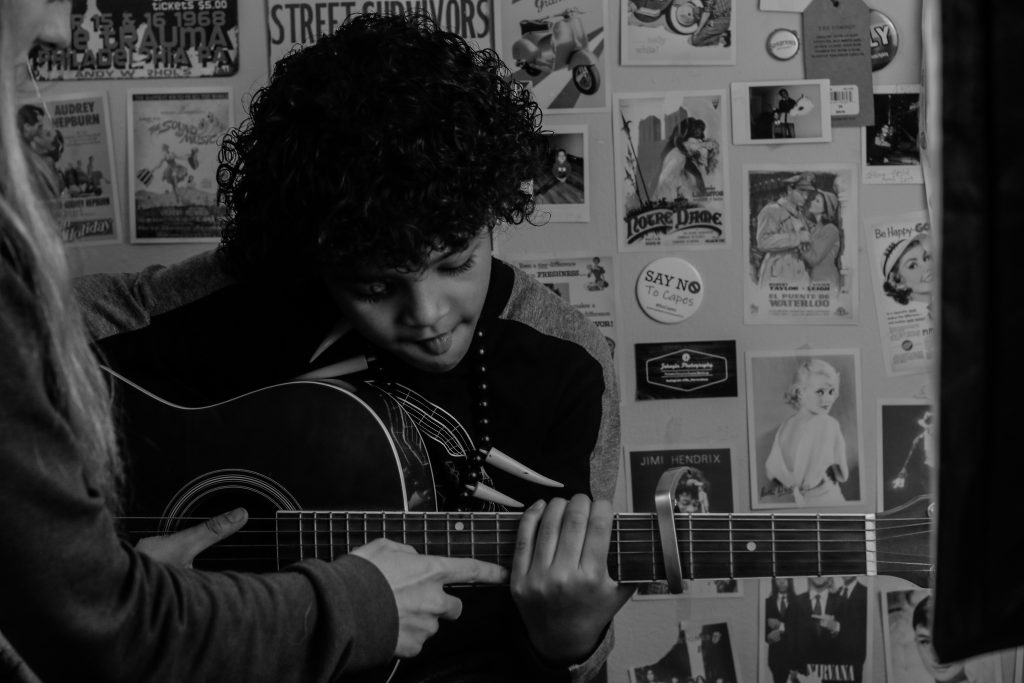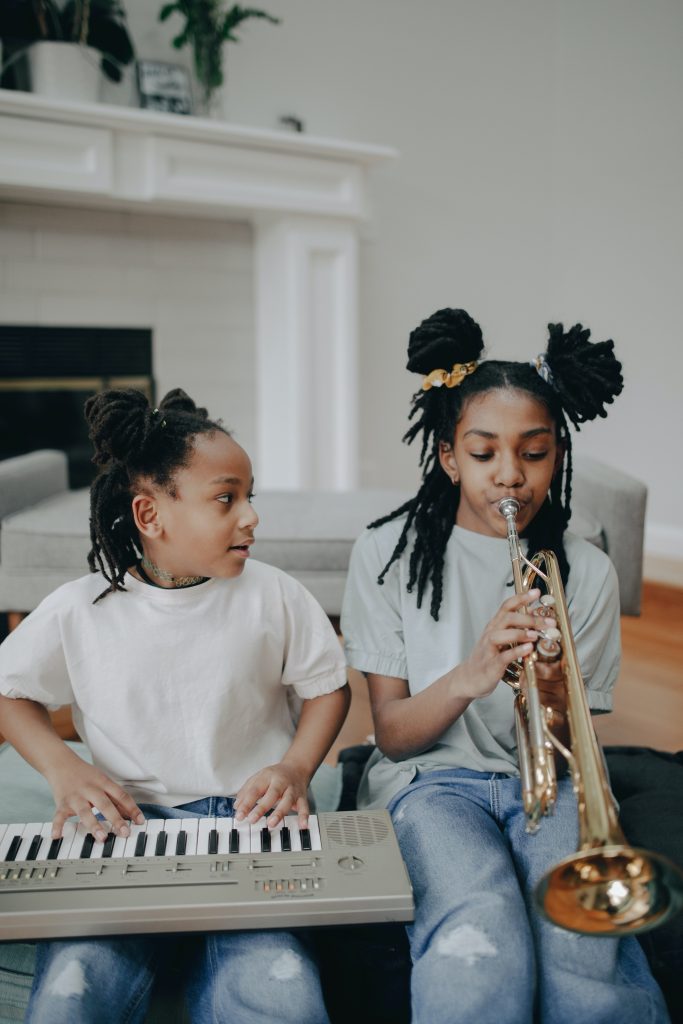The Melodies of Success: How Does Musical Learning Outside of School Transform Youths?
- Sébastien Boucher, PhD Candidate in Education, University of Québec in Montreal
- Francis Dubé, Professor of Extracurricular Instrumental Pedagogy, Laval University
- Jean-Philippe Després, Professor of Instrumental Didactics, Laval University
Music is among the extracurricular activities chosen by parents for their children. In Canada alone, over 2 million young people take music lessons outside of the school environment (Upitis & Smithrim, 2002). Beyond the sounds, the melodies played during youth help to cultivate skills that will resonate throughout one’s life.
This article shares scientific discoveries revealing the sometimes lesser-known benefits of learning a musical instrument for young people who engage in it outside of the school framework, such as during individual or group lessons at a private school or music conservatory.
Promoting Cognitive Development in Youths Through Music

Young individuals learning to play an instrument are not simply students: they are shaping their brain through music. Various studies (Costa-Giomi, 1999; Graziano et al., 1999; Schellenberg, 2004; Schlaug et al., 2005) have focused on the potential positive influence of music on the cognitive development of youths. This research often compared the performances of young instrumentalists to those of individuals of their
These studies highlight that learning music is an activity of choice that stimulates the young brain. Indeed, they achieved notably better performances in various fields, such as visuospatial abilities and mathematical skills. However, to capitalize on these benefits, it is imperative that young people maintain a regular and diligent engagement in their musical learning. Indeed, short-term benefits do not necessarily predict sustainable development if diligence decreases.
Developing Linguistic Skills
Music is a universal language, but its learning is also the “secret teacher” of language. Researchers have indeed hypothesized that certain abilities that developed while practicing music could be transferred during language learning. Indeed, young musicians seem to have a finer ear for linguistic subtleties. For example, some studies (François et al., 2013; Rauscher and Hilton, 2011) suggest that young people who practice an instrument are more adept at discerning sounds or distinguishing speech fragments than those who follow other types of teachings or who do not participate in any specific activity.
On the other hand, learning music would have a beneficial effect on language development. For instance, research conducted by Forgeard and colleagues (2008) established a positive relationship between this learning and the enrichment of a young musician’s vocabulary. Consequently, regular practice of a musical instrument promotes the development of a young person’s linguistic skills.
Fostering Relationships at the Heart of Well-being

Learning a musical instrument, whether practiced individually or in a group, encourages the creation of positive social bonds. Broh’s work (2002) highlights that music lessons encourage exchanges between parents, instrument teachers, and children, while supporting the latter’s personal esteem and motivation.
Furthermore, playing a musical instrument composes a symphony of benefits for the well-being of children and adolescents. For instance, in the study by Tolfree and Hallam (2016), participants expressed a sense of accomplishment and forged stronger self-confidence, finding in music an alternative way to express their emotions. They also shared their joy of learning with friends and their pride in overcoming occasional frustrations to master their pieces of music. Thus, the social bonds born from this musical practice have the power to strengthen the personal esteem and well-being of young musicians, while allowing them to transform their emotions into melodies.
In conclusion

Research highlights the positive impact of learning an instrument for young people who have musical experiences outside of, or in addition to, the school environment. The benefits of this learning are manifold, contributing to the intellectual, linguistic, social, and personal development of the child – advantages that also resonate harmoniously with parents!
It is important to keep in mind that the magnitude of these benefits aligns with the effort and perseverance of apprentice musicians. Thus, to maximize this range of benefits, it is essential to create a learning environment that encourages the curiosity and interest of youth. Here are some tips on this:
Our advice
Dialogue: Engage in a conversation with the youth to discover the musical adventures that excite them. Find out if they prefer individual or group lessons, the styles of music and instruments that attract them, and whether they are interested in creating melodies or rather in performing pieces composed by other artists or great composers.
Network: Given the crucial role of social support in maintaining enthusiasm for musical learning, encourage the youth to explore circles of people sharing their musical passions. This could be online groups, classmates with similar musical tastes, or music schools offering group lessons or group musical activities. By forging such connections, the young person will find a source of encouragement and sharing to enrich their musical journey.
Choice of the teacher: Find a music teacher whose values and personality match those of the youth, and who is able to adapt their teaching to their musical preferences. Look for someone who can harmonize their pedagogy with the youth’s specific interests.
References
Broh, B. A. (2002). Linking extracurricular programming to academic achievement: Who benefits and why? Sociology of Education, 75, 69–95.
Costa-Giomi, E. (1999). The effects of three years of piano instruction on children’s cognitive development. Journal of Research in Music Education, 47(5), 198–212.
Forgeard, M., Winner, E., Norton, A., & Schlaug, G. (2008). Practicing a musical instrument in childhood is associated with enhanced verbal ability and nonverbal reasoning. PloS one, 3(10), e3566.
François, C., Chobert, J., Besson, M., & Schön, D. (2013). Music training for the development of speech segmentation. Cerebral Cortex, 23(9), 2038-2043.
Graziano, A. B., Peterson, M., & Shaw, G. L. (1999). Enhanced learning of proportional math through music training and spatial-temporal training. Neurological Research, 21, 139–152.
Rauscher, F. H., & Hinton, S. C. (2011). Music instruction and its diverse extra-musical benefits. Music Perception, 29(2), 215-226.
Schellenberg, E. G. (2004). Music lessons enhance IQ. Psychological Science, 15(8), 511–514.
Schlaug, G., Norton, A., Overy, K., & Winner, E. (2005). Effects of music training on the child’s brain and cognitive development. Annals of the New York Academy of Science, 1060, 219–230.
Tolfree, E., & Hallam, S. (2016). Children and young people’s uses of and responses to music in their everyday lives: A pilot study. Psychology of Education Review, 40(2), 44-50.
Upitis, R., et Smithrim, K. (2002). Learning Through the Arts: National Assessment – A Report on Year 2 (200-2001). Toronto, ON.